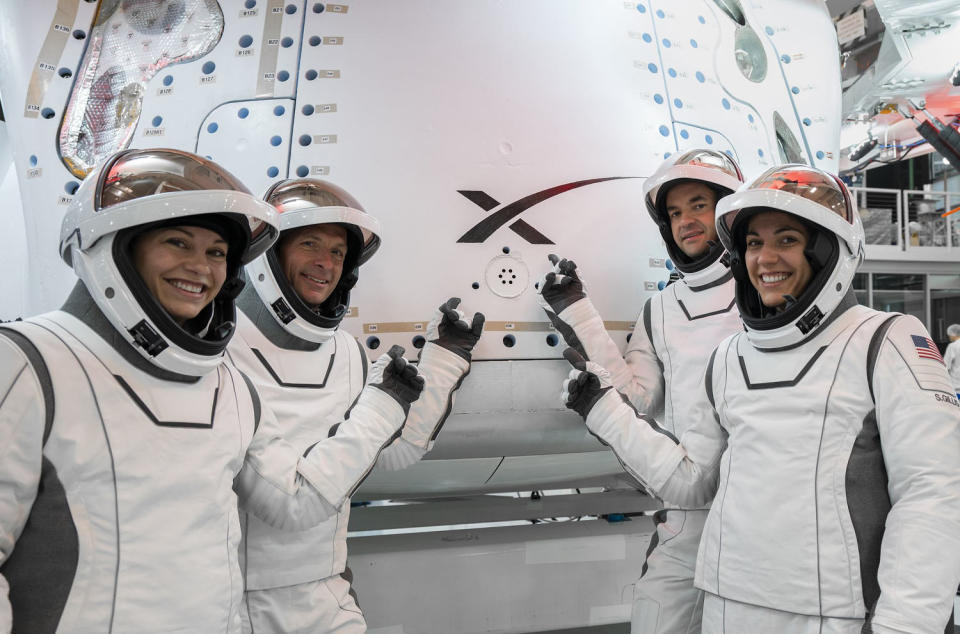SpaceX is preparing to launch its next private mission towards the end of the month, and it will feature the first attempt by astronauts to step into space.
The Polaris Dawn mission, the first of three flights that billionaire and Shift4 founder Jared Isaacman has purchased from SpaceX in 2022 for its human spaceflight effort known as the Polaris Program, is set to launch from Florida in the early hours of Aug. 26.
“We don’t have the freedom to launch it at any time of day but I think it will work [be] “Considering the mission, it happened pretty close to dawn, which is pretty convenient,” Isaacman said in an interview on CNBC’s Investing in Space last month.
Isaacman will command the mission, as he did when he led the historic Inspiration4 flight in 2021. He will once again lead a four-person crew, with longtime colleague Scott Poteet joining him as pilot and SpaceX employees Anna Menon and Sarah Gillis serving as the flight’s medical officer and mission specialist, respectively.
The multi-day journey will not have a destination, but instead will be a free-flying mission that follows orbits the crew hopes will take them far from Earth.
“We’re going to go to a very high altitude where humans haven’t gone in over 50 years,” Isaacman said.
But the focus of Polaris Dawn is the planned spacewalk.
Extravehicular activities, or EVAs, have been a regular part of NASA astronaut missions for years, such as when the agency needs to perform maintenance outside the International Space Station. But no private venture has attempted an EVA before.
Isaacman said that going on a spacewalk meant he and his crew “were surrounded by death,” and that they trained intensively for it.
“The closest thing to that is the vacuum chamber, and that’s where you feel as close as you can get to being in vacuum conditions or in space. … It definitely gives you the real sensations of pressure changes and temperature changes, and also the psychological stressors of being in a very challenging environment,” Isaacman said.
Five-day mission plan
Isaacman also detailed Polaris Dawn’s daily schedule, which will remain in space for up to five days.
Day one is all about finding a time when the risk from micrometeoroid orbital debris is minimized, which will determine when exactly Polaris Dawn will launch. After reaching a 120-mile-by-1,200-kilometer orbit, the crew will conduct extensive checks of SpaceX’s Dragon capsule, Resilience, Isaacman said.
“It’s really important to know that the vehicle is not faulty before you get to 1,400 kilometers,” Isaacman said.
The spacecraft will also make early passes through the high radiation region known as the South Atlantic Anomaly.
“You want to do it at the lowest altitude possible because even 200 kilometers down, the radiation levels are significantly higher… Two or three passes over the South Atlantic Anomaly at high altitude will account for almost the entire radiation load of the mission, equivalent to three months on the International Space Station,” Isaacman said.
The second day will focus on some of the science and research Polaris Dawn plans to conduct — which will include about 40 experiments. The crew will also prepare for a spacewalk and test their EVA suits.
“This way, we can be confident that nothing we can test on Earth in microgravity will be unexpected,” Isaacman said.
The third day is the most important day: EVA.
Spacewalk
So who from the crew will perform the spacewalk?
“We can say that all four of us did this; there is no airlock and the air is vented into the vacuum inside the spacecraft,” Isaacman said.
Two of the crew will travel outside the Dragon: Isaacman and Gillis, while Poteet and Menon remain inside as support.
The EVA is expected to take about two hours from start to finish. Isaacman emphasized that the spacewalk is “essentially a test and development” process.
“We want to learn as much as we can about the suit and the operation, but we only have a limited amount of oxygen and nitrogen to work with,” Isaacman said.
Polaris Dawn plans to livestream the spacewalk, and the mission commander stressed that there will be “a lot of cameras” inside and outside the capsule.

Brand new space suits
The most important equipment that aims to make EVA possible is SpaceX’s space suits.
Over the last few years, the company has taken its minimalist-looking, black-and-white IVA suit — the one worn by astronauts during in-car activities and emergencies — and used it to create the EVA suit. Isaacman said the EVA suits are the result of hundreds of hours of testing different materials over the years.
“So our primary goal is to learn as much as we can about the case,” Isaacman said.
“It’s all about building the next generation. We continue to iterate on this suit design so that SpaceX can one day have hundreds or thousands of them for the Moon, Mars. [low Earth orbit]“Anything. Making a new EVA suit is no easy task,” he added.
Polaris Dawn aims to push the boundaries of private spaceflight, and Isaacman hopes the mission will be as inspiring as his first trip to orbit.
“That’s the inspiring part about this… Anything that’s different from what we’ve seen in the last 20 or 30 years gets people excited and thinks, ‘If this is what I see today, I wonder what it’s going to be like tomorrow or a year from now.'”
You can read Isaacman’s Q&A on CNBC’s Investing in Space newsletter here.
This article was originally published on NBCNews.com